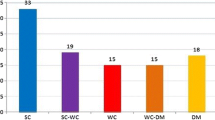Abstract
Chinese resultative compounds provide evidence that the thematic hierarchy is not the only factor determining the link between theta roles and syntactic arguments. Rather, it interacts with the causative hierarchy and when in conflict, can be overridden by the latter. This “asymmetrical” interaction between the two factors is shown to be responsible for the complex and, in some cases, totally unexpected patterns of ambiguity that resultative compounds demonstrate in various syntactic contexts. To the extent that the presence/absence of the causative hierarchy can be accurately predicted and its interaction with the thematic hierarchy explicitly specified, this paper lends support to the multi-dimensional nature of human language.
Similar content being viewed by others
References
Baker, Mark: 1988,Incorporation: A Theory of Grammatical Function Changing, University of Chicago Press, Chicago.
Cheng, Lisa: 1988, ‘Aspects of theBa-Construction’; in Carol Tenny (ed.),MIT Lexicon Project Working Papers 24, Cambridge, pp. 73–84.
Cheng, Lisa and Elizabeth Ritter: 1987, ‘A Small Clause Analysis of Inalienable Possession in Mandarin and French’, in James Blevins and Juli Carter (eds.),NELS 18, pp. 65–78.
Chomsky, Noam: 1981,Lectures on Government and Binding, Foris, Dordrecht.
Chu, Chauncey: 1973, ‘The Passive Construction: Chinese and English’,Journal of Chinese Linguistics 1, 437–470.
Comrie, Bernard: 1975, ‘Review of Jackendoff 1972’,Linguistics 160, 71–86.
Feng, Shengli: 1990, ‘The Passive Construction in Chinese’, unpublished manuscript, University of Pennsylvania.
Goodall, Grant: 1986, ‘On Argument Structure and L-marking with Mandarin Chineseba’, talk presented at NELS 17.
Goodall, Grant: 1989, ‘Evidence for an Asymmetry in Argument Structure’,Linguistic Inquiry 20, 669–674.
Goodall, Grant: 1991, ‘Mandarin Chinese Passives and the Nature of Case Absorption’, talk presented at the 3rd North American Conference on Chinese Linguistics, Ithaca.
Grimshaw, Jane: 1990,Argument Structure, MIT Press, Cambridge.
Hale, Kenneth and Jay Keyser: 1986, ‘Some Transitivity Alternations in English’,MIT Lexicon Project Working Papers 7, Cambridge.
Hale, Kenneth and Jay Keyser: 1987, ‘A View from the Middle’,MIT Lexicon Project Working Papers 10, Cambridge.
Hashimoto, Anne: 1971, ‘Mandarin Syntactic Structures’,Unicorn 8, 1–146.
Higginbotham, James: 1985, ‘On Semantics’,Linguistic Inquiry 16, 547–593.
Huang, James: 1982,Logical Relations in Chinese and the Theory of Grammar, Ph.D. dissertation, MIT.
Huang, James: 1988, ‘Wo Pao De Kuai and Chinese Phrase Structure’,Language 64, 274–311.
Jackendoff, Ray: 1972,Semantic Interpretation in Generative Grammar, The MIT Press, Cambridge.
Jackendoff, Ray: 1983,Semantics and Cognition, MIT Press, Cambridge.
Jackendoff, Ray: 1990,Semantic Structure, MIT Press, Cambridge.
Li, Audrey: 1990,Order and Constituency in Mandarin Chinese, Kluwer, Dordrecht.
Li, Charles and Sandra Thompson: 1981,Mandarin Chinese: A Functional Reference Grammar, University of California Press, Berkeley.
Li, Yafei: 1990a, ‘On V-V Compounds in Chinese’,Natural Language & Linguistic Theory 8, 177–207.
Li, Yafei: 1990b, ‘X0-binding and Verb-incorporation’,Linguistic Inquiry 21, 299–426.
Li, Yafei: 1993, ‘Structural Head and Aspectuality’,Language 69, 480–504.
Li, Yafei: to appear, ‘Chinese Resultative Constructions and the UTAH’, in J. Packard (ed.),Word Formation in Chinese, Mouton de Gruyter, Berlin.
Pesetsky, David: 1987, ‘Binding Problems with Experiencer Verbs’,Linguistic Inquiry 18, 126–140.
Pesetsky, David: 1995, ‘Zero Syntax’, MIT Press, Cambridge.
Pustejovsky, James: 1991, ‘The Syntax of Event Structure’,Cognition 41, 47–81.
Rosenberg, M: 1975, ‘Generative vs. Interpretive Semantics’,Foundations of Language 12, 561–582.
Thompson, Sandra: 1973, ‘Resultative Verb Compounds in Mandarin Chinese: A Case for Lexical Rules’,Language 49, 361–379.
Travis, Lisa: 1984,Parameters and Effects of Word Order Variation, Ph.D. dissertation, MIT.
Wang, Li: 1947,Zhongguo Xiandai Yufa, China Press, Shanghai.
Wang, Li: 1958,Hanyu Shirao, Science Press, Beijing.
Wang, Peter: 1986, ‘Additional Support for the Transformational Approach to MandarinBa andBei’, in S. Teng (ed.),Readings in Chinese Transformational Syntax, Crane Publishing Co., Taipei, pp. 67–75.
Author information
Authors and Affiliations
Additional information
The data as shown in (4) was brought to my attention by Bao Zhiming. I thank Jane Grimshaw for discussing the basic analysis with me at its beginning stage. Grimshaw (1990) has important influence on the ways in which my analysis is presented. This revised version benefits greatly from the detailed comments of threeNLLT reviewers and Carol Georgopoulos. I am also grateful to Emily Huang, Teng Qiuyun, Wang Yuyan, and Xie Qing for providing judgments on the Chinese data.
Rights and permissions
About this article
Cite this article
Li, Y. The thematic hierarchy and causativity. Nat Lang Linguist Theory 13, 255–282 (1995). https://doi.org/10.1007/BF00992783
Received:
Revised:
Issue Date:
DOI: https://doi.org/10.1007/BF00992783




